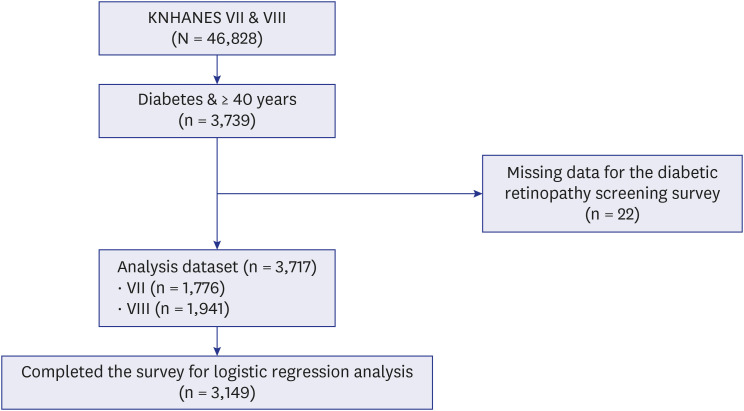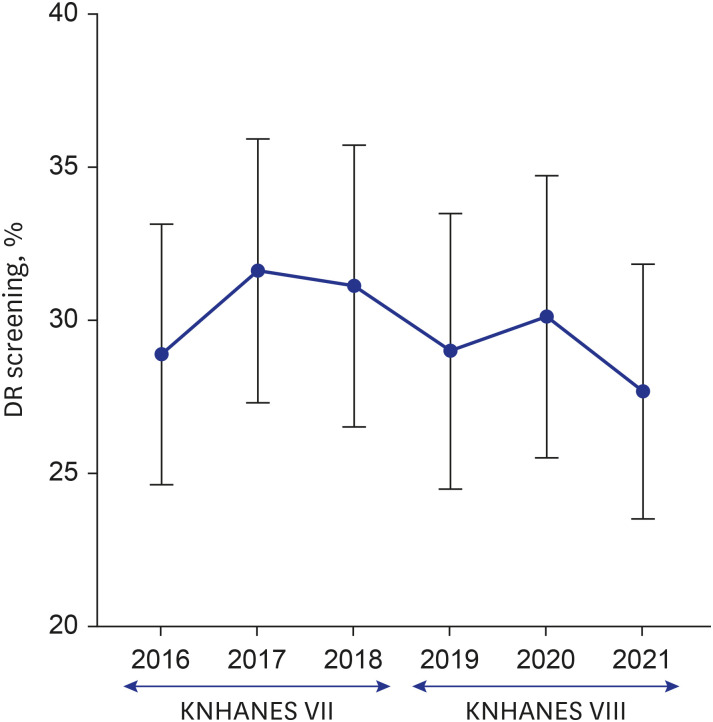J Korean Med Sci.
2024 Jul;39(27):e203. 10.3346/jkms.2024.39.e203.
Trends and Barriers in Diabetic Retinopathy Screening: Korea National Health and Nutritional Examination Survey 2016–2021
- Affiliations
-
- 1Department of Ophthalmology, Seoul National University Bundang Hospital, Seoul National University College of Medicine, Seongnam, Korea
- KMID: 2557780
- DOI: http://doi.org/10.3346/jkms.2024.39.e203
Abstract
- Background
The prevalence of diabetes is increasing globally, highlighting the importance of preventive healthcare. This study aimed to identify the diabetic retinopathy (DR) screening rates and risk factors linked to DR screening nonadherence in the Korean population through a nationally representative sample survey.
Methods
Among the Korea National Health and Nutrition Examination Survey database from 2016 to 2021, participants aged ≥ 40 years with diabetes were included. The weighted estimate for nonadherence to DR screening within a year was calculated. Risk factor analyses were conducted using univariate and multivariate logistic regression.
Results
Among the 3,717 participants, 1,109 (29.5%) underwent DR screening within the past year, and this national estimate exhibited no statistically significant difference from 2016 to 2021 (P = 0.809). Nonadherence to annual DR screening was associated with residing in rural areas, age ≥ 80 years, low educational level, self-reported good health, absence of ocular disease, current smoking, lack of exercise and dietary diabetes treatment, and no activity limitation (all P < 0.05).
Conclusion
The recent DR screening rate in Korea was relatively low. Factors associated with apathy and complacency towards personal health were associated with the nonadherence to DR screening. Educational interventions have the potential to enhance the annual screening rate for diabetic patients.
Keyword
Figure
Reference
-
1. Cheung N, Mitchell P, Wong TY. Diabetic retinopathy. Lancet. 2010; 376(9735):124–136. PMID: 20580421.2. Lundeen EA, Burke-Conte Z, Rein DB, Wittenborn JS, Saaddine J, Lee AY, et al. Prevalence of diabetic retinopathy in the US in 2021. JAMA Ophthalmol. 2023; 141(8):747–754. PMID: 37318810.3. Sabanayagam C, Banu R, Chee ML, Lee R, Wang YX, Tan G, et al. Incidence and progression of diabetic retinopathy: a systematic review. Lancet Diabetes Endocrinol. 2019; 7(2):140–149. PMID: 30005958.4. Jang HN, Moon MK, Koo BK. Prevalence of diabetic retinopathy in undiagnosed diabetic patients: a nationwide population-based study. Diabetes Metab J. 2022; 46(4):620–629. PMID: 35193173.5. Rim TH, Byun IH, Kim HS, Lee SY, Yoon JS. Factors associated with diabetic retinopathy and nephropathy screening in Korea: the Third and Fourth Korea National Health and Nutrition Examination Survey (KNHANES III and IV). J Korean Med Sci. 2013; 28(6):814–820. PMID: 23772143.6. Korea Disease Control and Prevention Agency. Guideline for Data Users of Korea National Health and Nutrition Examination Survey. Cheongju, Korea: Korea Centers for Disease Control and Prevention;2023.7. Bae JH, Han KD, Ko SH, Yang YS, Choi JH, Choi KM, et al. Diabetes fact sheet in Korea 2021. Diabetes Metab J. 2022; 46(3):417–426. PMID: 35656565.8. Chung YR, Ha KH, Lee K, Kim DJ. Diabetic retinopathy and related clinical practice for people with diabetes in Korea: a 10-year trend analysis. Diabetes Metab J. 2020; 44(6):928–932. PMID: 32662253.9. Eppley SE, Mansberger SL, Ramanathan S, Lowry EA. Characteristics associated with adherence to annual dilated eye examinations among US patients with diagnosed diabetes. Ophthalmology. 2019; 126(11):1492–1499. PMID: 31281055.10. Kim TH, Chun KH, Kim HJ, Han SJ, Kim DJ, Kwak J, et al. Direct medical costs for patients with type 2 diabetes and related complications: a prospective cohort study based on the Korean National Diabetes Program. J Korean Med Sci. 2012; 27(8):876–882. PMID: 22876053.11. Park YS, Kim SY, Park EC, Jang SI. Screening for diabetes complications during the COVID-19 outbreak in South Korea. Int J Environ Res Public Health. 2022; 19(9):5436. PMID: 35564832.12. Yoo KJ, Lee Y, Lee S, Friebel R, Shin SA, Lee T, et al. The road to recovery: impact of COVID-19 on healthcare utilization in South Korea in 2016–2022 using an interrupted time-series analysis. Lancet Reg Health West Pac. 2023; 41:100904. PMID: 37780633.13. Shih KC, Kwong AS, Wang JH, Wong JK, Ko WW, Lai JS, et al. Diabetic retinopathy screening during the coronavirus disease 2019 pandemic. Eye (Lond). 2020; 34(7):1246–1247. PMID: 32367007.14. Chun JW, Kim HS. The present and future of artificial intelligence-based medical image in diabetes mellitus: focus on analytical methods and limitations of clinical use. J Korean Med Sci. 2023; 38(31):e253. PMID: 37550811.
- Full Text Links
- Actions
-
Cited
- CITED
-
- Close
- Share
- Similar articles
-
- Factors Associated with Screening for Diabetic Retinopathy in Diabetic Patients Aged > or = 40 Years Using the KNHANES IV
- Current Challenges in Diabetic Retinopathy: Are We Really Doing Better?
- Association between Grapes Intake and Diabetic Retinopathy: Inhibitory Effect of Resveratol on Diabetic Retinopathy
- Factors Associated with Diabetic Retinopathy and Nephropathy Screening in Korea: The Third and Fourth Korea National Health and Nutrition Examination Survey (KNHANES III and IV)
- Current status of nutritional screening in periodic health examination



